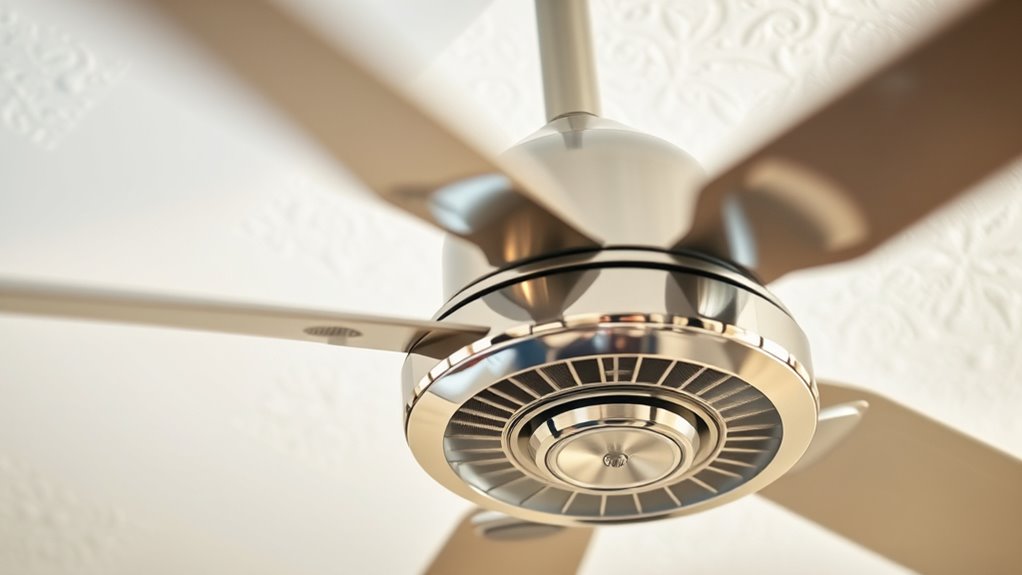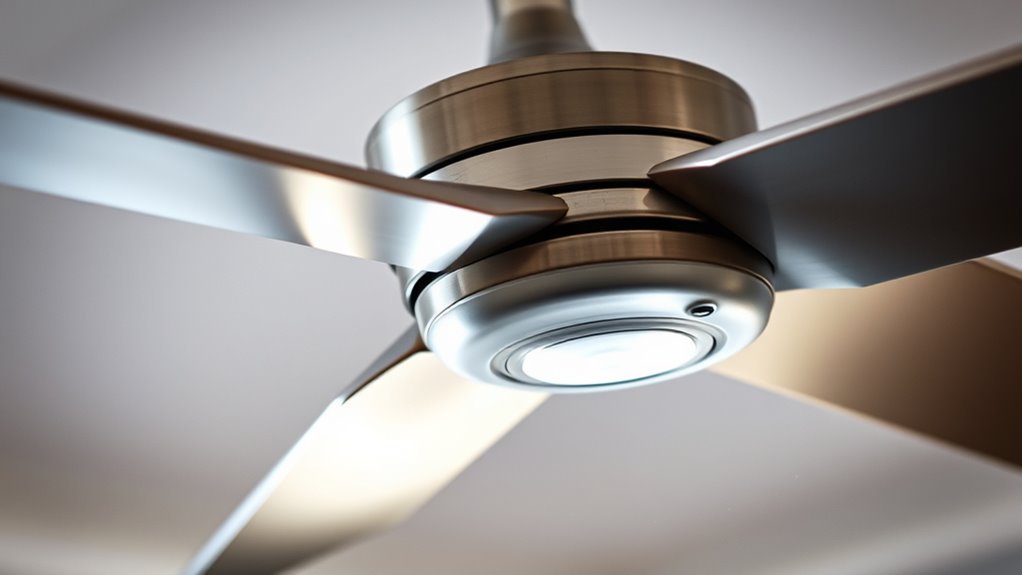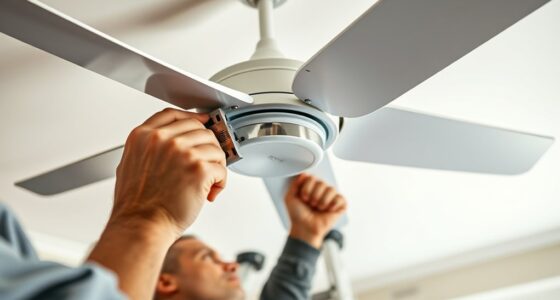When your ceiling fan hums or buzzes, start by inspecting the mounting hardware for loose screws or brackets and tighten them securely. Check electrical connections inside the switch housing and motor terminal for tightness and signs of wear, using a multimeter to verify voltage. Test the capacitor with a meter, replacing it if it shows lower capacitance. Finally, verify the blades are properly aligned and free of damage. Continuing further can reveal precise troubleshooting steps to eliminate noise completely.
Key Takeaways
- Turn off the fan and check for loose or damaged blades, tightening or replacing as needed.
- Inspect electrical connections inside the canopy for loose wiring and secure all connections.
- Test and replace the capacitor if it shows signs of failure or low capacitance.
- Lubricate motor bearings if accessible, or consider professional inspection for internal faults.
- Ensure the fan is properly mounted and balanced to reduce vibrations causing buzzing sounds.

A ceiling fan that produces a persistent buzzing noise can indicate a mechanical or electrical issue requiring diagnosis. To address this, you need to systematically examine each component involved in the fan’s operation. Start by inspecting the mounting hardware. Loose screws or brackets in the fan’s mounting assembly can cause vibrations that translate into audible buzzing. Use a screwdriver to tighten all mounting screws securely, ensuring the fan’s motor and blades are firmly attached to the ceiling. Check the blade alignment as well; uneven or warped blades can create imbalance, leading to vibrations and noise. If blades are warped or damaged, replace or straighten them according to manufacturer specifications.
Next, turn your attention to the fan’s electrical connections. Loose wiring or poor contact within the switch housing or at the motor terminals can produce buzzing sounds. Carefully disconnect the power supply at the circuit breaker before opening the fan’s canopy. Once exposed, verify that all wire connections are tight and properly secured, with no frayed or exposed conductors. Use a multimeter to check for consistent voltage at the motor terminals, ensuring proper electrical supply. Faulty or degraded wiring should be replaced immediately to prevent further electrical issues or safety hazards.
Check wiring connections and test voltage at motor terminals for safe operation.
You should also examine the capacitor, which plays a crucial role in the fan’s starting and running torque. A failing or faulty capacitor can cause irregular motor operation, resulting in humming or buzzing noises. To test the capacitor, first discharge it safely by shorting its terminals with an insulated screwdriver. Then, remove it from the circuit and use a multimeter with capacitance testing capability. Compare the reading to the manufacturer’s specifications; if it’s considerably lower or shows no capacitance, replace the capacitor. This step is critical, as a defective capacitor not only causes noise but can also damage the motor if left unaddressed.
Additionally, consider the fan’s motor itself. Worn bearings or internal mechanical faults can generate continuous noise. Lubricate the motor’s bearings if they are accessible, using manufacturer-recommended lubricants. If noise persists after lubrication, you might need to replace the motor or have a professional inspect it for internal damage. Finally, ensure that the fan’s speed control switch is functioning correctly. Faulty switches can cause irregular motor operation and noise. Replace the switch if testing indicates malfunction. Regular maintenance and inspection of electrical components can also help prevent future buzzing issues.
Frequently Asked Questions
Can a Humming Ceiling Fan Cause Electrical Fires?
A humming ceiling fan can potentially cause electrical fires if the issue stems from wiring problems, such as loose connections or damaged insulation, which generate heat and sparks. Faulty capacitors or worn-out motor components may also increase fire risk due to overheating. Regular inspections, tightening connections, and replacing damaged parts help prevent electrical hazards. If the humming persists or worsens, consult a qualified electrician promptly to assess and address the underlying cause.
How Often Should I Lubricate My Ceiling Fan?
Think of your ceiling fan as a finely tuned instrument that needs regular care to perform smoothly. You should lubricate your fan every 1-2 years, or more often if it’s in a dusty or humid environment. Use a lightweight, high-quality oil on the motor’s bearings, applying it carefully to avoid overspill. Proper lubrication reduces friction, prevents squeaks, and prolongs your fan’s lifespan, ensuring quiet, efficient operation.
Is It Safe to Operate a Buzzing Fan?
Yes, operating a buzzing ceiling fan is generally safe if the noise results from minor issues like loose screws or dust. However, persistent buzzing may indicate electrical problems or worn components, which could pose safety risks. You should inspect the fan’s mounting, blades, and connections, and consider turning it off if the noise worsens or if you notice unusual vibrations or smells. When in doubt, consult a professional electrician.
Can a Ceiling Fan Hum Due to Remote Control Issues?
Ever wonder if your remote control could cause that humming noise? Yes, a faulty or incompatible remote can interfere with your ceiling fan’s receiver, leading to humming or buzzing sounds. This occurs when the remote’s signals cause electrical interference or the receiver’s circuitry malfunctions. To fix this, check the remote batteries, reset the remote and receiver, or replace the remote if necessary. Ensuring compatibility and proper functioning can eliminate the noise effectively.
What Are Signs of a Failing Ceiling Fan Motor?
You’ll notice your ceiling fan motor is failing if it starts making persistent grinding, squealing, or rattling noises, indicating internal bearing wear or lubrication issues. You might observe reduced airflow or inconsistent speeds, suggesting electrical or mechanical failure. Overheating, burnt smell, or visible burn marks on the motor housing also signal imminent motor failure. If these signs appear, it’s essential to inspect the wiring, lubricate moving parts, or consider replacing the motor to prevent complete failure.
Conclusion
When your ceiling fan hums or buzzes, it’s like a minor glitch in an otherwise smooth symphony. Carefully inspecting the blades, tightening loose wires, and lubricating the motor can restore harmony. If the noise persists, consider replacing worn-out parts or consulting a professional. Treat your fan like a finely-tuned instrument—regular maintenance keeps it humming quietly and efficiently, ensuring it continues to circulate air seamlessly and quietly, rather than becoming a discordant note in your space.








